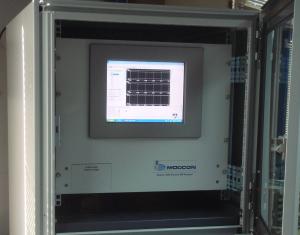Transforming Process Industry Applications with AI-Enabled Chemometrics
The integration of artificial intelligence (AI) and chemometrics is revolutionizing petroleum, renewable energy and biotechnology industry applications.
LONDON, UNITED KINGDOM, August 7, 2024 /EINPresswire.com/ -- The integration of artificial intelligence (AI) and chemometrics is revolutionizing process industry applications, particularly in petroleum, renewable energy and biotechnology sectors. As the backbone of these industries, effective process control is essential to maintaining peak performance and minimizing financial losses. The advent of AI-enabled chemometrics, particularly in Near-Infrared (NIR) spectroscopy, marks a significant advancement in this field.The bedrock of process industry applications is effective process control, which ensures operations are executed with peak efficiency, unerring accuracy, and minimized costs. Incorporating on-line process analyzers is universally recognized as a crucial step to prevent financial losses, often resulting from redundant re-processing or superfluous giveaways. The discourse has evolved beyond the mere adoption of analyzers to a more nuanced debate about selecting the optimal analyzer type—one that guarantees top-tier performance without compromising on cost-effectiveness.
Process industry applications often employ correlative analyzers, which correlate spectra with physical properties. These analyzers are gaining popularity and importance as they replace traditional analytical technologies that require more maintenance and offer significantly lower reliability. Correlative analyzers operate differently. They do not measure chemical or physical properties according to well-defined procedures but use mathematics and algorithms to correlate between the spectrum and different physical properties of a chemical composition. This relates to the effect that overall physical properties and the spectral pattern are the result of the contribution of each individual compound that is present in a chemical composition in a process stream.
Chemometrics, an interdisciplinary field, fuses mathematical and statistical methodologies to extract valuable information from chemical datasets. Essentially, chemometrics employs mathematical models to unravel complex chemical datasets, illuminating hidden patterns or relationships. In the industrial context, the vastness and complexity of chemical data necessitate tools like chemometrics to distill actionable insights.
Software platforms like Unscrambler X, SIMCA, and Minitab have been pivotal in facilitating chemometric analyses. While powerful, these platforms often demand a robust understanding of both the intricacies of chemometrics and the software mechanics—a steep learning curve that can deter many from adopting them. The intertwining of machine learning (ML) technologies with chemometrics has emerged as a beacon of hope. Machine learning, with its innate capability to discern patterns from colossal datasets without explicit programming, complements chemometrics, especially when grappling with extensive, multifaceted data.
Benefits of merging ML into chemometrics include efficiency and simplicity, automation minimizes manual interventions and their associated errors; scalability, ML models effortlessly scale with growing datasets; and adaptability, these models adapt to evolving data patterns, ensuring enduring relevance.
The secret to harnessing their full potential lies in a diligent approach to modeling, especially considering the opacity constraints of certain liquids. The spectral outcomes, influenced by the variable composition of raw materials and especially by hetero-atomic molecules, necessitate strategies for mitigation. A significant hurdle for industries is the depth of expertise required to craft mathematical models. Integrating ML into the chemometric landscape offers a solution. Modern ML-driven platforms are designed for intuitiveness, eliminating the need for profound knowledge in either domain. Users simply input data, and the software orchestrates the rest, producing precise and interpretable models.
Furthermore, plant laboratories often employ measurements adhering to ASTM standards, recognized benchmarks in materials testing. Integrating these measurements into model updates guarantees that the models are not only current but also aligned with industry standards. These automatic updates, combined with the latest data, continually refine the model, enhancing its real-world applicability and ensuring adherence to ASTM methods.
Expanding on these concepts, technologies like NIR (Near-Infrared Spectroscopy2) have seen successful integration into various process industry applications, such as those in petroleum, renewable energy, and biotechnology. These technologies are empowered by optical fibers that transmit NIR beams over long distances, facilitating simultaneous measurement of diverse process streams. The real triumph is the embedded validation software that consistently cross-checks the NIR analytical findings against laboratory analyses.
The industry's ultimate goal is achieving models that are both sophisticated and contemporaneous. This is where solutions like Modcon.AI3 step in, offering automated modeling software tailored for NIR analyzers. Harnessing machine learning, Modcon.AI empowers users with an intuitive interface and automated updates, ensuring models are always state-of-the-art.
Modcon.AI, developed by the London-based company Modcon Systems1, addresses these challenges with its automated modeling software tailored for NIR analyzers. Utilizing machine learning, Modcon.AI ensures high measurement precision by continuously incorporating the latest reference data. Its intuitive interface, graphical model precision representation, and extensive reporting functionalities make it accessible to a broader user base.
Automated modeling achieves quality comparable to manual updates, optimizing machine learning models, performing predictions, and identifying outliers for exclusion from training data. An intuitive interface provides users with a user-friendly platform for model management and data analysis. High precision ensures that NIR analyzer users can leverage the most up-to-date models for enhanced performance.
NIR spectrometry has become a staple in various industries, including petrochemicals, renewable energy and biotechnology. Modcon Systems has implemented online analysis for clients worldwide, providing NIR analyzers and automatic modeling software. The integration of chemometrics, machine learning, and NIR spectroscopy offers transformative benefits for process industry applications, promising sophisticated analyses, streamlined operations, and adherence to global standards.
Modcon Systems is at the forefront of process control in various industries, leveraging advanced technologies to deliver superior analytical solutions. With a commitment to innovation and excellence, Modcon Systems empowers industries with state-of-the-art tools for optimized performance and efficiency.
Anya Alter
Modcon Systems Ltd.
+44 20 4577 1737
email us here
Visit us on social media:
LinkedIn
YouTube
1 https://www.modcon-systems.com/
2 https://www.modcon-systems.com/project/nir-analyzer/
3 https://modcon.ai/


